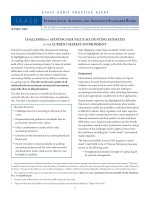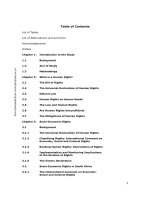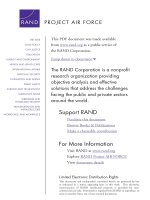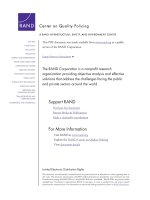ECONOMIC DEVELOPMENT IN AFRICA Fostering industrial development in aFrica in the new global environment doc
Bạn đang xem bản rút gọn của tài liệu. Xem và tải ngay bản đầy đủ của tài liệu tại đây (1.7 MB, 135 trang )
United nations ConferenCe
on trade and development
UNCTAD/ALDC/AFRICA/2011
United nations indUstrial
development organization
ECONOMIC
DEVELOPMENT IN
REPORT 2011
UNCTAD
UNIDO
A
F
R
I
C
A
Fostering industrial
development in aFrica in the
new global environment
T
here is mounting evidence
indicating that industrial
development presents great
opportunities for sustained
growth, employment and
poverty reduction. Conse-
quently, over the past decade, African
governments have renewed their political
commitment to industrialization and have
adopted several initiatives at the national
and regional levels to enhance prospects
of achieving their development objectives.
The Economic Development in Africa
Report 2011 examines the status of
industrial development in Africa with a
focus on the identication of “stylized facts”
associated with African manufacturing. It
also provides an analysis of past attempts
at promoting industrial development
in the region and the lessons learned
from these experiences. Furthermore, it
offers policy recommendations on how
to foster industrial development in Africa
in the new global environment, which is
characterized by changing international
trade rules, growing influence of
industrial powers from the South, the
internationalization of production, and
increasing concerns about climate change.
The Report argues that a new
industrial policy is needed to induce
structural transformation and engender
development in African economies. It
advocates a strategic approach to
industrial policymaking which is based
on an industrial diagnosis, and proposes
a framework for industrial strategy design
which takes account of the heterogeneity
of African economies and is also tailored
to country-specific circumstances.
Furthermore, the Report suggests that
efforts to promote industrial development
in Africa should focus on (a) the promotion
of scientic and technological innovation;
(b) the creation of linkages in the
domestic economy; (c) the promotion of
entrepreneurship; (d) the improvement of
government capabilities; (e) adoption of
appropriate monetary and scal policies;
(f) avoiding exchange rate overvaluation;
(g) enhancing resource mobilization; (h)
strengthening regional integration; and (i)
maintenance of political stability.
www.unctad.org/Africa/series
SPECIAL ISSUE
Economic Development in Africa Report 2011
UNITED NATIONS
EMBARGO
The contents of this Report must not be
quoted or summarized in the print,
broadcast or electronic media before
11 July 2011, 17:00 hours GMT
SPECIAL ISSUE
New York and Geneva, 2011
United nations ConferenCe
on trade and development
U n i t e d n at i o n s i n d U s t r i a l
development organization
ECONOMIC
DEVELOPMENT IN
REPORT 2011
FOSTERING INDUSTRIAL
DEVELOPMENT IN AFRICA IN THE
NEW GLOBAL ENVIRONMENT
ii
Economic Development In Africa Report 2011
Copyright © United Nations, 2011
All rights reserved.
UNCTAD/ALDC/AFRICA/2011
UNITED NATIONS PUBLICATION
Sales No. E.11.II.D.14
ISBN 978-92-1-112825-3
ISSN 1990–5114
NOTE
Symbols of United Nations documents are composed of capital letters combined
with gures. Mention of such a symbol indicates a reference to a United Nations
document.
The designations employed and the presentation of the material in this publication
do not imply the expression of any opinion whatsoever on the part of the Secretariat
of the United Nations concerning the legal status of any country, territory, city or area,
or of its authorities, or concerning the delimitation of its frontiers or boundaries.
Material in this publication may be freely quoted or reprinted, but acknowledgement
is requested, together with a reference to the document number. A copy of the
publication containing the quotation or reprint should be sent to the UNCTAD
secretariat.
iii
ACKNOWLEDGEMENTS
Acknowledgements
The Economic Development in Africa Report 2011 is the product of joint work
between UNCTAD and UNIDO. It was prepared by a research team consisting
of Norbert Lebale (team leader), Patrick Osakwe (UNCTAD), Bineswaree Bolaky
(UNCTAD), Milasoa Chérel-Robson (UNCTAD) and Philipp Neuerburg (UNIDO).
The work was completed under the overall supervision of Charles Gore, Head,
Research and Policy Analysis Branch (UNCTAD); Ludovico Alcorta, Director,
Development Policy and Strategic Research Branch, Regional Strategy and Field
Operations Division (UNIDO); and Jo Elizabeth Butler, Deputy-Director and Ofcer-
in-Charge, Division for Africa, Least Developed Countries and Special Programmes
(ALDC). The report beneted from the comments of the following, who participated
in a peer review discussion of a draft of the report: Olusanya Ajakaiye, Director of
Research, African Economic Research Consortium, Nairobi, Kenya; Helmut Asche,
University of Leipzig, Germany; Michele di Maio, Department of Economic Studies,
University of Naples, Italy; Erika Kraemer-Mbula, Institute for Economic Research
and Innovation (IERI), Pretoria, South Africa; Zeljka Kozul-Wright (UNCTAD); Detlef
Kotte (UNCTAD); and Alfredo Saad Filho (UNCTAD).
Statistical assistance was provided by Agnès Collardeau-Angleys (UNCTAD), and
Gorazd Rezonja (UNIDO). Heather Wicks and Stephanie West provided secretarial
support. The cover was prepared by Sophie Combette based on a design by
Hadrien Gliozzo. Lucy Deleze-Black and Michael Gibson edited the text.
The overall layout, graphics and desktop publishing were done by Madasamyraja
Rajalingam.
v
CONTENTS
CONTENTS
Explanatory notes vii
Abbreviations . viii
CHAPTER I: INTRODUCTION 1
CHAPTER 2: PROMOTING INDUSTRIAL DEVELOPMENT IN AFRICA:
STAGES, PERFORMANCE AND LESSONS LEARNED 9
A. Stages of industrial development in Africa 10
B. The performance and characteristics of African manufacturing 14
C. Lessons learned 26
CHAPTER 3: TOWARDS A NEW INDUSTRIAL POLICY IN AFRICA:
INDUSTRIAL DIAGNOSIS AND STRATEGY DESIGN 33
A. Introduction 34
B. The question of strategic choice and selectivity in facilitating
structural change 36
C. A framework for industrial strategy design 39
D. Applying the framework: a typology of African countries’ industrial
performance 43
E. Applying the framework: linking countries with different strategic choices 54
F. Steps in the industrial strategy design process 56
CHAPTER 4: TOWARDS A NEW INDUSTRIAL POLICY IN AFRICA:
THE WHY AND THE HOW OF POLICY-MAKING 59
A. The rationale for industrial policy 60
B. Key principles of new industrial policy 64
C. The areas and instruments of new industrial policy 67
D. Institutional and governance issues 71
E. The importance of complementary policies 71
F. Financing industrial development: Where will the resources for
industrialization come from? 74
G. The role of regional integration 79
CHAPTER 5: TOWARDS A NEW INDUSTRIAL POLICY IN AFRICA:
TAKING ACCOUNT OF THE NEW GLOBAL
ENVIRONMENT 85
A. International trade rules 86
vi
Economic Development In Africa Report 2011
B. Rising industrial powers from the South 92
C. Climate change 95
D. Global value chains 98
E. Summary 101
CHAPTER 6: FOSTERING INDUSTRIAL DEVELOPMENT IN AFRICA:
MAIN FINDINGS AND RECOMMENDATIONS 103
A. Main ndings 105
B. Policy recommendations 106
C. Conclusion 110
NOTES 112
REFERENCES 115
BOXES
1. Floriculture in Ethiopia: An African success story 63
2. The West African Common Industrial Policy 80
TABLES
1. Contribution of industry to GDP 1970-2008 15
2. African manufacturing by sectors and technological classication
2000-2009 19
3. Structure of African manufacturing exports: top 10 export products by
technology category 20
4. Manufacturing performance of African countries 27
5. Industrial structure of selected African countries 2009 49
6. Cost of infrastructure services in Africa 73
FIGURES
1. Structural transformation of Africa’s economy vis-à-vis other developing
regions 16
2. Structural transformation of Africa’s exports vis-à-vis other
developing regions 16
3. Importance of low technology manufacturing exports and trade balance 21
4. A strategic approach to industrial policy making in Africa 35
vii
CONTENTS
5. Framework for the comparative assessment of the relative attractiveness
and strategic feasibility of manufacturing activities for African countries 41
6. Illustration of the relative attractiveness and feasibility of unused potentials
in various manufacturing industries 43
7. Typology of African countries based on industrial performance 45
8. An overview of African countries’ industrialization level and growth
performance 46
9. African countries’ industrial performance 47
10. GDP per capita in Africa and the BRIC countries 83
EXPLANATORY NOTES
The $ sign refers to the United States dollar.
Sub-Saharan Africa: Except where otherwise stated, this includes South
Africa.
North Africa: In this publication, Sudan is classied as part of sub-Saharan
Africa, not North Africa.
viii
Economic Development In Africa Report 2011
ABBREVIATIONS
AFC African Finance Corporation
AfDB African Development Bank
AID Africa Industrialization Day
AIDA accelerated industrial development of Africa
BRIC Brazil, Russian Federation, India and China
CAMI Conference of African Ministers of Industry
CCS carbon capture and storage
CDM Clean Development Mechanism
DAC Development Assistance Committee
DBSA Development Bank of Southern Africa
DESA Department of Economic and Social Affairs
EBA Everything But Arms
ECOWAS Economic Community of West African States
EITI Extractive Industries Transparency Initiative
EPA economic partnership agreement
EPZ export processing zone
EU European Union
FDI foreign direct investment
GATT General Agreement on Tariffs and Trade
GDP gross domestic product
GHG greenhouse gases
GSP Generalized System of Preferences
GVCs global value chains
HIPC heavily indebted poor countries
IMF International Monetary Fund
IPAP Industrial Policy Action Plan
IPR intellectual property protection regime
ISI import substitution industrialization
LDCs least developed countries
LT low technology
MDG Millennium Development Goals
MFN most favoured nation
MHT medium and high technology
MVA manufacturing value added
NAMA non-agricultural market access
NCPC national cleaner production centers
ix
NEPAD New Partnership for Africa’s Development
NIC newly industrialized country
NIPF national industrial policy framework
ODA ofcial development assistance
OECD Organization for Economic Cooperation and Development
POSCO Pohang Iron and Steel Company
PRSP poverty reduction strategy papers
RB Resource-based
SAP structural adjustment programme
SCM subsidies and countervailing measures
SEZ special economic zone
SME small and medium-sized enterprise
TRIMs Trade-related Investment Measures
TRIPs Trade-related Aspects of Intellectual Property Rights
UNECA United Nations Economic Commission for Africa
UNEP United Nations Environment Programme
UNFCCC United Nations Framework Convention on Climate Change
UNIDO United Nations Industrial Development Organization
WACIP West African Common Industrial Policy
WTO World Trade Organization
ABBREVIATIONS
INTRODUCTION
1
CHAPTER
INTRODUCTION
2
Economic Development In Africa Report 2011
THE POLITICAL COMMITMENT TO
INDUSTRIALIZATION IN AFRICA
After gaining political independence, which occurred mainly in the 1960s,
most African countries started to promote industrialization. The emphasis on
industrialization was based on the political conviction by African leaders that it was
necessary to ensure self-reliance and reduce dependence on advanced countries.
Furthermore, there was the expectation that industrialization would hasten the
transformation of African countries from agricultural to modern economies,
create employment opportunities, raise incomes as well as living standards,
and reduce vulnerability to terms of trade shocks resulting from dependence on
primary commodity exports. But during the 1970s, with successive oil shocks
and an emerging debt problem, it started to become clear that import substitution
industrialization was not sustainable. With the introduction of structural adjustment
programmes in the 1980s, African countries curtailed specic policy efforts
to promote industrialization and focused on removing anti-export biases and
furthering specialization according to comparative advantage. It was expected that
competitive pressures would revitalize economic activity by leading to the survival
of the ttest. But whilst these policies were certainly intended to have structural
effects, the conventional view is that they did not boost industrialization in the
region (Soludo, Ogbu and Chang 2004).
In recent years, African countries have demonstrated renewed commitment to
industrialization as part of a broader agenda to diversify their economies, build
resilience to shocks, and develop productive capacity for high and sustained
economic growth, the creation of employment opportunities and substantial poverty
reduction. For instance, in January 2007, the South African Government adopted
the National Industrial Policy Framework (NIPF) aimed at diversifying the production
and export structure, promoting labour-absorbing industrialization, moving towards
a knowledge economy, and contributing to the industrial development of the
region. It has also unveiled Industrial Policy Action Plans (IPAP) to implement the
framework. The rst IPAP was adopted by the National Cabinet in August 2007 and
was for the period 2007/08 while the second IPAP was adopted in February 2009
and covers the period 2010/11 to 2012/13. Other countries in the region have also
taken steps recently to build a modern, competitive, and dynamic industrial sector.
For example, industrialization is a component of recent national development
programmes unveiled by Egypt, Ethiopia, Kenya, Namibia, Nigeria and Uganda
(Altenburg, 2011).
3
The commitment of African countries to industrialization is also evident at the
regional level. The New Partnership for Africa’s Development (NEPAD) adopted by
African leaders in 2001 identied economic transformation through industrialization
as a critical vehicle for growth and poverty reduction in the region. Furthermore, in
February 2008, African Heads of State adopted a Plan of Action for the Accelerated
Industrial Development of Africa (AIDA). Implementation strategies for the Plan
were subsequently endorsed by African Ministers at the 2008 Conference of
African Ministers of Industry (CAMI).
1
At the 2011 CAMI organized by the African
Union, the United Nations Industrial Development Organization (UNIDO) and the
Government of Algeria, participants deliberated on the effective implementation
of AIDA and how to achieve sustainable industrial development in Africa. The new
commitments build on past regional initiatives such as the Lagos Plan of Action
(1980), the Abuja Treaty establishing the African Economic Community (adopted
in 1991), and the Alliance for Africa’s Industrialization (1996), which also stressed
the need for diversication and economic transformation as a critical vehicle for
achieving African self-reliance.
At the global level, there is also interest in drawing attention to issues and
challenges of industrial development in Africa as evidenced by the fact that at the 85
th
plenary meeting of the United Nations General Assembly held in December 1989,
the international community adopted Resolution 44/237 proclaiming 20 November
as the Africa Industrialization Day (AID). The AID is an annual event coordinated
by UNIDO and the rst celebration was held in 1990. The AID is used to mobilize
support and commitment of the international community to the industrialization
of Africa. It is also an occasion for African countries to review progress made in
industrial development and chart a way forward. The theme for the AID varies from
year to year. In 2010 the event was held under the theme Competitive Industries for
the Development of Africa.
THE RATIONALE FOR RENEWED COMMITMENT
TO INDUSTRIALIZATION
The renewed commitment to promoting industrial development in Africa is
timely. African countries have been buffeted by three very serious and interrelated
external shocks, namely hikes in food prices, increases in energy prices and
the global nancial and economic crisis triggered by events in the United States
housing market in the fall of 2007. The economic and social costs of the triple
CHAPTER 1. Introduction
4
Economic Development In Africa Report 2011
crises in Africa have been quite substantial. The growth rate of real output fell from
an annual average of 5.2 per cent over the period 2000–2006 to 2.6 per cent in
2009. Similarly, the growth rate of real output per capita fell from 2.7 per cent to
0.3 per cent over the same period. The crises have also eroded recent gains made
by African countries in poverty reduction and reduced prospects of achieving the
Millennium Development Goals (MDG) by the target date (Osakwe 2010).
The triple crises have refocused attention on Africa’s high vulnerability to external
shocks and the need for policymakers to take urgent action to diversify their
production and export structure to build resilience to shocks. The region is currently
the least diversied in the world and, more importantly, has made relatively very
slow progress in this area in the last two decades. The export diversication index
for the region improved slightly from 0.61 in 1995 to 0.58 in 2009.
2
In developing
countries in Asia, it fell from 0.32 to 0.26 and for developing America it fell from
0.36 to 0.33.
Recent research suggests that economic development requires structural
change from low to high productivity activities and that the industrial sector is a
key engine of growth in the development process (Lall, 2005; Rodrik, 2007; Hesse,
2008). Virtually all cases of high, rapid and sustained economic growth in modern
economic development have been associated with industrialization, particularly
growth in manufacturing production (Szirmai 2009). Commodity exports can lead
to high but not sustained economic growth.
The necessity of structural change also arises from the fact that Africa needs
high and sustained economic growth in order to make signicant progress in
reducing poverty. One of the major challenges which African countries currently
face is to generate productive jobs and livelihoods for the 7–10 million young
people entering the labour force each year. This is difcult to achieve simply through
commodity exports but rather requires a complementary process of agricultural
productivity growth and development of non-agricultural employment opportunities
in both industry and services. If African countries are to achieve substantial poverty
reduction and also the Millennium Development Goals (MDGs), they have to go
through a process of structural transformation involving a decrease in the share of
agriculture and an increase in the share of industry and modern services in output,
with a shift between and within sectors from lower productivity to higher productivity
activities.
5
THE STRATEGIC IMPORTANCE OF MANUFACTURING
The industrial sector is, in general, dened as being composed of manufacturing,
mining and construction. However, there is a large literature that suggests that
the manufacturing sector is the component of industry that presents greater
opportunities for sustained growth, employment and poverty reduction in Africa.
The United Nations Department of Economic and Social Affairs (DESA) denes
manufacturing as the physical or chemical transformation of materials, substances
or components into new products. The materials, substances or components
transformed are raw materials that are products of agriculture, forestry, shing,
mining or quarrying or products of other manufacturing activities. Substantial
alteration, renovation or reconstruction of goods is generally considered to be
manufacturing.
The strategic role of manufacturing in the development process can be ascribed
to a variety of factors. The rst is that technology and innovation are crucial for
economic development and manufacturing has historically been the main source of
innovation in modern economies (Lall, 2005; Gault and Zhang, 2010). The research
and development activities of manufacturing rms have been the key source of
technological advances in the world economy (Shen, Dunn and Shen, 2007).
Furthermore, manufacturing is a major conduit for diffusion of new technologies to
other sectors of the economy.
Another advantage of manufacturing relative to other sectors is that there are
very strong linkage and spill-over effects associated with manufacturing activities.
For example, it is well known that manufacturing is a critical source of demand for
other sectors. In particular, manufacturing rms are important consumers of banking,
transport, insurance and communication services. Furthermore, manufacturing
provides demand stimulus for growth of the agricultural sector. Consequently,
manufacturing has high forward and backward linkages, thereby contributing to
domestic investment, employment and output in the development process.
Manufacturing is also attractive because, following Engel’s law, the share of
agriculture in total household expenditure falls as per capita income rises while the
share of manufactures increases. This implies that manufactures offer signicant
opportunities for export market expansion and therefore is a key driver of growth
in merchandise trade. Interestingly, countries that have derived signicant benets
from the tremendous increase in merchandise trade over the past three decades
CHAPTER 1. Introduction
6
Economic Development In Africa Report 2011
are those that have been able to increase their exports of dynamic products,
particularly manufactures, with high income elasticity of demand. Consequently,
what a country produces and exports matters (Hausmann, Hwang and Rodrik
2007).
Manufacturing also has a higher potential for employment creation relative
to agriculture and traditional services. In particular, the existence of diminishing
returns to scale in agriculture (due to xed factors such as land) implies that the
opportunities for employment growth in the sector are limited. Consequently, as
a country’s population grows and urbanization takes place, there is the need for
growth in manufacturing employment to absorb labour displaced from agriculture.
Despite the critical role of manufacturing in the development process, it is
important that African policymakers do not seek to achieve industrial development at
the expense of the agricultural sector because the latter can contribute to industrial
development through, for example, the supply of wage goods that enhance the
competitiveness of domestic rms in global export markets. Rattso and Torvik
(2003) show that discrimination against the agriculture sector could lead to the
contraction of industry, through trade linkages. De Janvry and Sadoulet (2010)
stress the need for complementarity between agriculture and industry. They also
argue that agricultural development can contribute to the creation of competitive
advantage in industry. Furthermore, in the short-to-medium term, the agriculture
sector will continue to be an important source of foreign exchange required to import
intermediate inputs needed by domestic industries. It is also important to recognize
that the provision of producer services also matters for the competitiveness of
the manufacturing sector. In this context, the challenge for policymakers is how
to create mutually supportive linkages between the industrial and non-industrial
sectors of the economy.
THE NEW GLOBAL ENVIRONMENT
The global environment for African industrialization is also changing in several
signicant respects and efforts to promote industrialization in the twenty-rst
century must also take account of this new environment. First, multilateral trade
rules as well as bilateral and regional trade agreements are shrinking the policy
space available for promoting industrial development in African countries that are
not classied as Least Developed Countries (LDCs). For example, the rules of the
World Trade Organization (WTO) prohibit the use of industrial policy instruments
7
such as quotas and local content requirements. The use of export subsidies have
also been banned, except for the LDCs (Chang, 2009; Rodrik, 2004). Furthermore,
as a result of the Economic Partnership Agreements (EPAs), African countries are
under increasing pressure to abandon the use of tariffs as a measure of protection.
Consequently, African industrialization is taking place in an environment in which the
use of some industrial policy instruments applied by the developed and emerging
economies are either banned or regulated.
Second, the global environment in which manufacturing production takes place
has also changed in the sense that rms are increasingly facing stiff competition
in global export markets due to the reduction in tariff and non-tariff barriers to
trade in industrial products coupled with the signicant decrease in transport costs
and improvements in information and communication technology. For African
countries, the new environment is challenging because of the rise and growing role
of large developing countries such as China, India and Brazil in labour-intensive
manufactures (Kaplinsky, 2007). These new competitive pressures imply that an
effective response to competition is no longer just about selling products at lower
cost. It is also about producing better products and getting them to consumers in
a timely manner.
Third, increasing concerns over climate change are forcing rms to adopt or
switch to new technologies and methods of production. In particular, manufacturers
are under increasing pressure to adopt climate-friendly technologies and methods
of production. Consequently, if African industrialization is to be sustainable it cannot
rely on the old technologies and methods of production used by the developed
countries when they were at a similar stage of development.
THE FOCUS AND ORGANIZATION OF THIS REPORT
Against this background, the 2011 Economic Development in Africa Report
focuses on the topic Fostering Industrial Development in Africa in the New Global
Environment. The Report provides an overview of the stages, performance and
lessons learned from previous attempts at promoting industrial development in
Africa (chapter 2). It then goes on to discuss key elements for a new industrial policy
for Africa. This must begin with a careful diagnosis of the current situation and
strategy design. A framework for this, as well as a typology of African countries, is
set out in chapter 3. Chapter 4 goes on to discuss the why and the how of industrial
policy, whilst chapter 5 indicates how the policy may be calibrated with the new
CHAPTER 1. Introduction
8
Economic Development In Africa Report 2011
global environment. The concluding chapter summarizes the major ndings and
policy messages of the Report.
The Report is the product of joint work, and is jointly published by UNCTAD
and the United Nations Industrial Development Organization (UNIDO). It builds
on the 2009 Economic Development in Africa Report on Strengthening Regional
Economic Integration for Africa’s Development and the 2010 Report on South-
South Cooperation: Africa and the New Forms of Development Partnerships. It
also builds on the 2009 UNIDO Industrial Development Report on Breaking in and
Moving up: New Industrial Challenges for the Bottom Billion and the Middle-income
Countries.
PROMOTING INDUSTRIAL
DEVELOPMENT IN AFRICA:
STAGES, PERFORMANCE
AND LESSONS LEARNED
2
CHAPTER
PROMOTING INDUSTRIAL
DEVELOPMENT IN AFRICA:
STAGES, PERFORMANCE
AND LESSONS LEARNED
10
Economic Development In Africa Report 2011
This chapter presents a short overview of attempts to promote industrialization
in Africa and then discusses the past performance and current characteristics of
Africa’s manufacturing sector with a view to drawing lessons for the future.
A. STAGES OF INDUSTRIAL DEVELOPMENT IN AFRICA
While there are differences across countries in terms of the starting dates for the
industrialization programmes, it is evident that industrial development in Africa has
gone through three broad phases or stages since independence. The rst phase
which began in the 1960s and ended in the late 1970s is the import substitution
industrialization (ISI) phase. The second phase, which represents the structural
adjustment programme (SAP) phase, began in the early 1980s and ended in the
late 1990s. The third phase, the poverty reduction strategy papers (PRSP) phase,
began in 2000.
The import substitution industrialization phase
The ISI phase of industrial development in Africa began after political
independence in the 1960s up until the late 1970s. As in other developing country
regions, ISI in Africa started with the domestic production of consumer goods that
were previously imported. The idea was that the domestic markets for these goods
already existed and could form the basis for initiating an industrialization programme.
While the initial focus was on consumer goods, there was the expectation that, as
the industrialization process proceeds, there will also be domestic production of
intermediate and capital goods needed by the domestic consumer goods industry.
There was also the expectation and hope that the replacement of imported goods
with domestically produced goods would, over time, enhance self-reliance and
help prevent balance-of-payments problems.
The implementation of ISI involved substantial government support as well as
protection of domestic rms from foreign competition. In particular, domestic infant
industries were identied and nurtured through trade protection and other domestic
economic policies. This was rationalized on the grounds that domestic rms have
the potential to be competitive but require a temporary period of protection before
they could withstand international competition.
3
Although there are country-specic
differences in policies adopted, the implementation of ISI in Africa generally involved
the following elements: (a) restriction of imports to intermediate inputs and capital
goods required by domestic industries; (b) extensive use of tariff and non-tariff
11
barriers to trade; (c) currency overvaluation to facilitate the import of goods needed
by domestic industries; (d) subsidized interest rates to make domestic investment
attractive; (e) direct government ownership or participation in industry; and (f)
provision of direct loans to rms as well as access to foreign exchange for imported
inputs (Mkandawire and Soludo, 2003; Wangwe and Semboja, 2003).
The share of manufacturing in African gross domestic product (GDP) rose
substantially between 1970 and 1980 (table 1). However, it became evident in
the late 1970s that industrial development through the ISI model could not be
sustained for a variety of reasons. First, very few of the domestic rms supported
actually became fully competitive in international markets (Wangwe and Semboja,
2003). Second, ISI has a high foreign exchange requirement in the early phase
since it involves imports of intermediate inputs and capital goods needed by
domestic industries. However, the implementation of ISI in most African countries
did not lay emphasis on the generation of foreign exchange. Agriculture was also
neglected. In particular, the focus of ISI was more on setting up factories rather than
building the entrepreneurial capabilities that would foster industrial dynamism and
the development of competitive export sectors. In addition, the domestic economic
policies adopted during the period implicitly taxed agriculture and exports thereby
reducing foreign exchange earnings. Consequently, in the late 1970s, the scarcity
of foreign exchange became a serious constraint on industrial development in the
region. It should be noted, however, that while the implementation of ISI in Africa
generally had an anti-export bias, there is evidence suggesting that in countries
such as Mauritius and Zimbabwe, the protection of the domestic market allowed
rms to accumulate resources and invest in the development of capabilities needed
for exporting (Wangwe, 1995; Lall and Wangwe, 1998).
The structural adjustment programmes phase
The SAP phase in Africa began in the early 1980s and ended in the late 1990s. In
particular, its origin could be traced back to the early 1980s, when African countries
experienced severe balance of payments crisis resulting from the cumulative effects
of the oil crisis, the decline in commodity prices, and the growing import needs
of domestic industries. In response to the crisis, many countries sought nancial
assistance from the International Monetary Fund (IMF) and the World Bank. The IMF/
World Bank interpretation of the crisis and Africa’s industrial development problems
were that it had to do with poor domestic policies and so the recommendation
was that African countries adopt SAPs (Soludo, Ogbu and Chang, 2004). This
CHAPTER 2. Promoting Industrial Development in Africa
12
Economic Development In Africa Report 2011
interpretation and policy prescription was based on the ndings of the Berg Report
on Accelerated Development in Sub-Saharan Africa: An Agenda for Action published
by the World Bank in 1981. The report argued that Africa’s economic and industrial
performance was poor because of policy inadequacies in the form of overvalued
exchange rates, interest rate controls, overemphasis on industry at the expense
of agriculture, and trade protectionism. In addition, the report was of the view that
Africa’s comparative advantage lay in agriculture and not industry. Consequently, it
did not share the popular view among African policymakers that industry should be
promoted through deliberate government intervention.
African countries that adopted SAPs were expected to implement certain
policy reforms as a condition for receiving nancial assistance from the IMF and the
World Bank. The policy conditions included among other things: (a) deregulation
of interest rates; (b) trade liberalization; (c) privatization of State–owned enterprises
(parastatals); (d) withdrawal of government subsidies; and (e) currency devaluation.
One of the key objectives of SAPs was to reduce the role of the State in the
industrialization and development process and give market forces more room in the
allocation of resources. The assumption was that markets are more efcient than
the State in resource allocation and that the appropriate role of the latter should be
to provide an enabling environment for the private sector to ourish.
Critics of SAP argue that it placed Africa on a low-growth path, undermined
economic diversication efforts, and led to an erosion of the industrial base in the
region (Sundaram and von Arnim, 2008; Mkandawire, 2005; Soludo, Ogbu and
Chang, 2004; Stein, 1992). In particular, the focus on liberalization of markets
coupled with the phasing out of various forms of interventionist policies supporting
manufacturing drove many domestic rms out of business. This resulted in the
destruction of what remained of the local industry base despite the potential of
technological upgrading in some of the existing domestic rms (Lall, 1995). In
Mozambique, for example, the reduction in the strategic role of the State during the
SAP period undermined attempts to promote industrial development. There is also
evidence that in Ghana, Nigeria and Zambia, trade liberalization under SAP exposed
domestic rms to import competition and led to the closure of some manufacturing
rms (Lall and Mwangwe, 1998).
To summarize, the expectation that SAP would make African rms more
competitive, trigger industrial development, and lay the foundation for sustained
economic growth has not been realized. As was the case with ISI, the adoption
13
of SAP did not lead to the attainment of the objective of structural transformation
and export diversication in Africa. Against this backdrop, in the late 1990s African
policymakers began to reappraise their development strategies with a view to
avoiding some of the mistakes made in the ISI and SAP phases.
The PRSP phase
By the second half of the 1990s, many African countries had accumulated
enormous foreign debt and the burden of debt service became an obstacle to
growth and development. In response to this challenge, in 1996 donors launched
the Heavily Indebted Poor Countries (HIPC) initiative designed to provide relief to
severely indebted countries. Dissatisfaction with the slow progress of the HIPC
initiative in reducing the debt of poor countries led to the adoption of the enhanced
HIPC initiative in 1999 (Booth, 2003). As a precondition for participation in the
enhanced HIPC initiative, potential recipients were required to prepare PRSPs
detailing how the resources made available through debt relief would be used
to reduce poverty in the recipient country. In particular, recipient countries were
encouraged to invest the resources from debt relief in the social sectors such as
health and education (particularly at the primary and secondary levels). Consequently,
since 2000, most African countries considered eligible for participation in the HIPC
programme have prepared PRSPs, giving priority to spending on health as well as
primary and secondary education. Therefore, the year 2000 marked the beginning
of another phase of policy design and implementation that had implications for
industrialization in the region.
While the PRSP differs from the ISI and SAP in the sense that it was specically
designed as a debt relief programme, it is evident that it did have consequences
for industrial development in Africa because the rst generation PRSPs led to a
shift of resources from the production to the social sectors. The second generation
PRSPs have tried to address the social sector bias problem associated with the
rst generation PRSPs. However, interest in the productive sectors in second
generation PRSPs in Africa tends to be in agriculture and its related industries,
reecting largely the widespread view that African countries have a comparative
advantage in these industries and that agriculture is an important source of pro-
poor growth. For an in-depth analysis of the implications of the PRSP for Africa’s
economic development see UNCTAD (2006).
CHAPTER 2. Promoting Industrial Development in Africa
14
Economic Development In Africa Report 2011
B. THE PERFORMANCE AND CHARACTERISTICS OF
AFRICAN MANUFACTURING
This section examines the past performance and current characteristics of
Africa’s manufacturing sector with a view to identifying some stylized facts on the
development of manufacturing in the region. It should be noted however that there
is a high degree of heterogeneity across African countries and so manufacturing
performance will vary across countries. The main stylized facts identied in the data
are as follows.
The contribution of manufacturing to GDP peaked in 1990 and fell
thereafter
The share of African manufacturing in GDP rose from a low of 6.3 per cent in
1970 to a peak of 15.3 per cent in 1990 (Table 1). Since then, there has been a
signicant decline in the contribution of manufacturing to GDP. In particular, the
share of manufacturing in GDP fell from 15.3 per cent in 1990 to 12.8 per cent
in 2000 and 10.5 per cent in 2008. It is interesting to note that the decline in
the contribution of manufacturing to GDP since 1990 has been observed in all
subregions of the continent. In Eastern Africa, the share of manufacturing in GDP
fell from 13.4 per cent in 1990 to 9.7 per cent in 2008. In West Africa it fell from 13.1
to 5 per cent over the same period. Furthermore, in Southern Africa, it fell from 22.9
to 18.2 per cent and in Northern Africa it fell from 13.4 to 10.7 per cent.
Africa still accounts for a very low share of global manufacturing
As indicated by the small bubble sizes in gures 1 and 2, Africa continues to
be marginalized in global manufacturing production and trade. The share of the
region in global manufacturing value added fell from 1.2 per cent in 2000 to 1.1
per cent in 2008. In developing Asia, it rose from 13 per cent to 25 per cent and
in developing countries in Latin America it fell from 6 per cent to 5 per cent over
the same period. There has also been no signicant change in the region’s share
of global manufacturing exports in recent years. In particular, while Africa’s share
of global manufacturing exports rose slightly from 1 per cent in 2000 to 1.3 per
cent in 2008, in low- and middle-income countries in East Asia and the Pacic
it rose from 9.5 per cent in 2000 to 16 per cent in 2008. Furthermore, in low-









